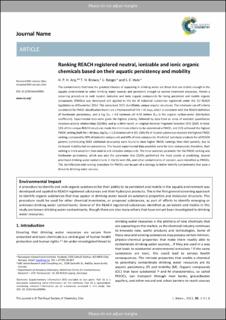| dc.description.abstract | The contaminants that have the greatest chances of appearing in drinking water are those that are mobile enough in the aquatic environment to enter drinking water sources and persistent enough to survive treatment processes. Herein a screening procedure to rank neutral, ionizable and ionic organic compounds for being persistent and mobile organic compounds (PMOCs) is presented and applied to the list of industrial substances registered under the EU REACH legislation as of December 2014. This comprised 5155 identifiable, unique organic structures. The minimum cut-off criteria considered for PMOC classification herein are a freshwater half-life >40 days, which is consistent with the REACH definition of freshwater persistency, and a logDoc < 4.5 between pH 4–10 (where Doc is the organic carbon–water distribution coefficient). Experimental data were given the highest priority, followed by data from an array of available quantitative structure–activity relationships (QSARs), and as a third resort, an original Iterative Fragment Selection (IFS) QSAR. In total, 52% of the unique REACH structures made the minimum criteria to be considered a PMOC, and 21% achieved the highest PMOC ranking (half-life > 40 days, logDoc < 1.0 between pH 4–10). Only 9% of neutral substances received the highest PMOC ranking, compared to 30% of ionizable compounds and 44% of ionic compounds. Predicted hydrolysis products for all REACH parents (contributing 5043 additional structures) were found to have higher PMOC rankings than their parents, due to increased mobility but not persistence. The fewest experimental data available were for ionic compounds; therefore, their ranking is more uncertain than neutral and ionizable compounds. The most sensitive parameter for the PMOC ranking was freshwater persistency, which was also the parameter that QSARs performed the most poorly at predicting. Several prioritized drinking water contaminants in the EU and USA, and other contaminants of concern, were identified as PMOCs. This identification and ranking procedure for PMOCs can be part of a strategy to better identify contaminants that pose a threat to drinking water sources. | |
